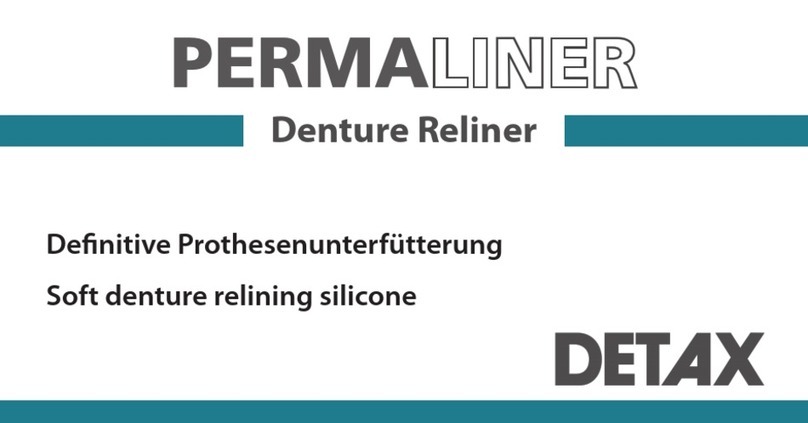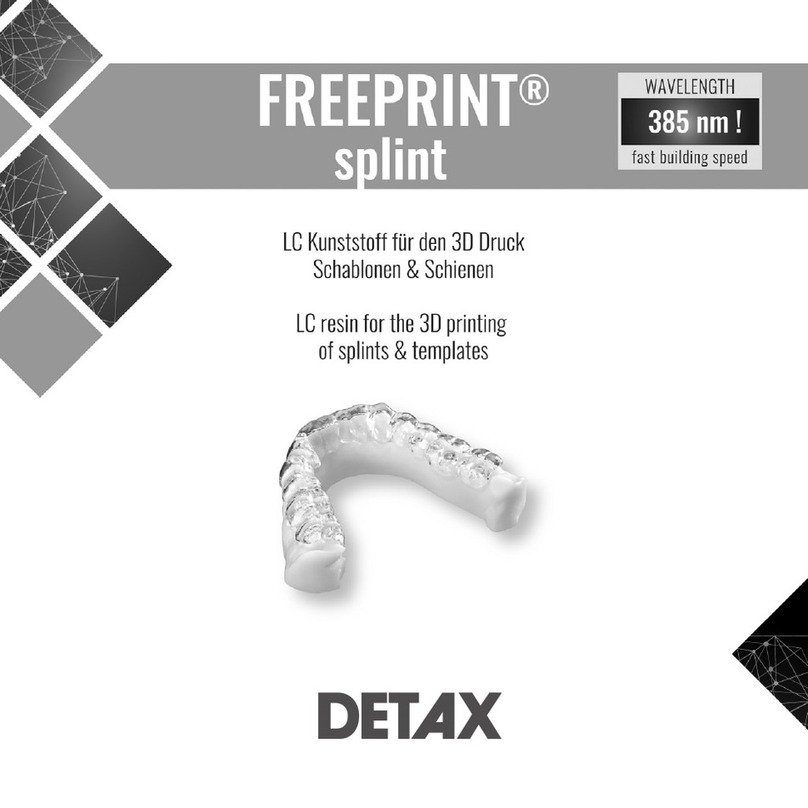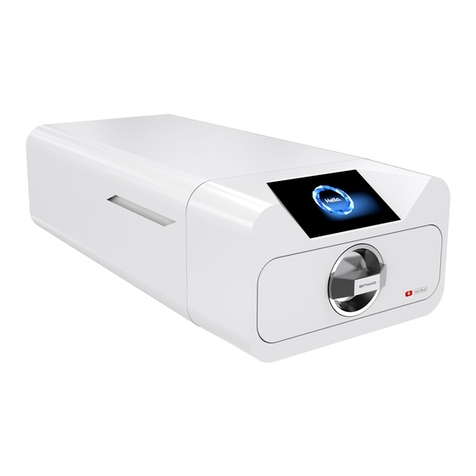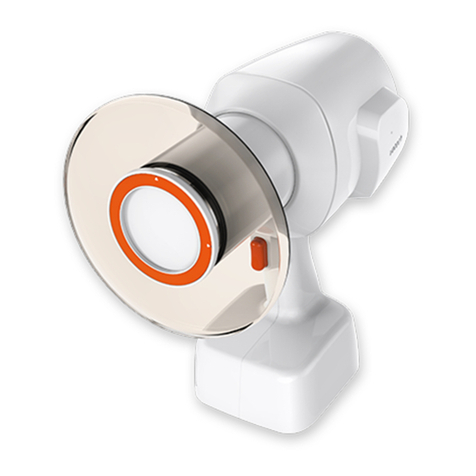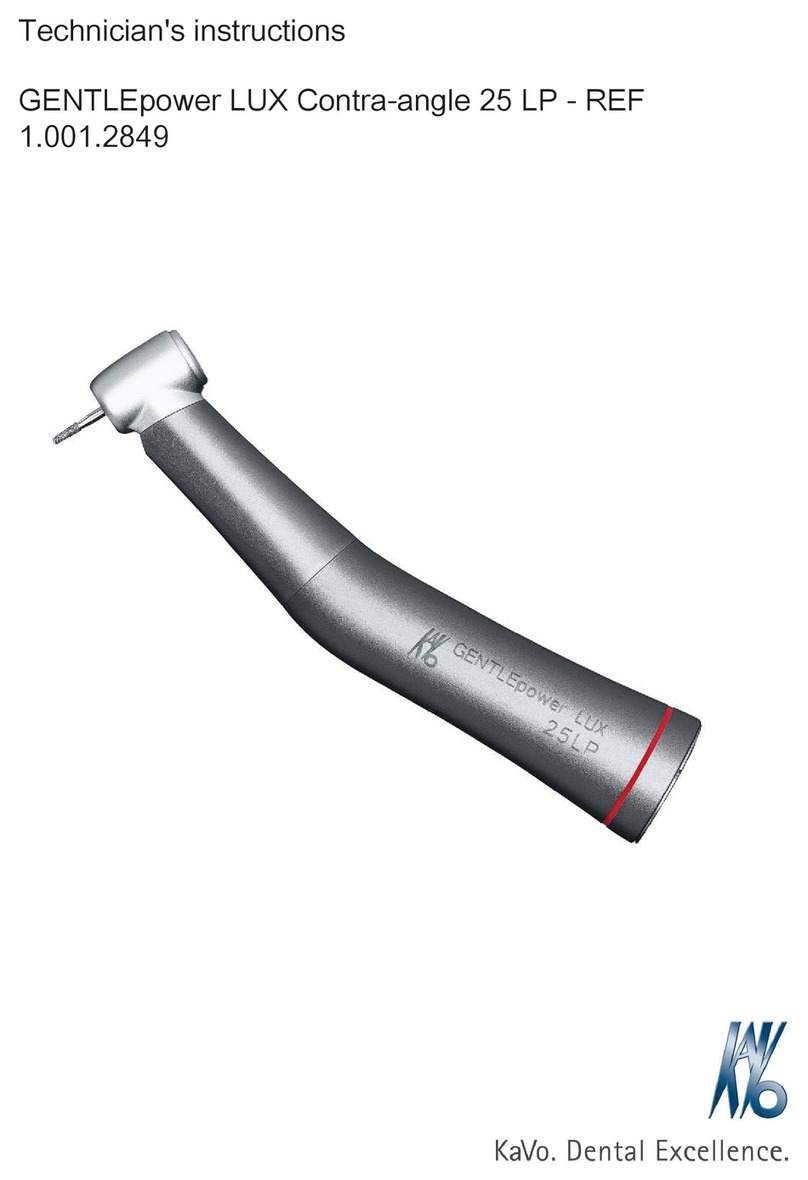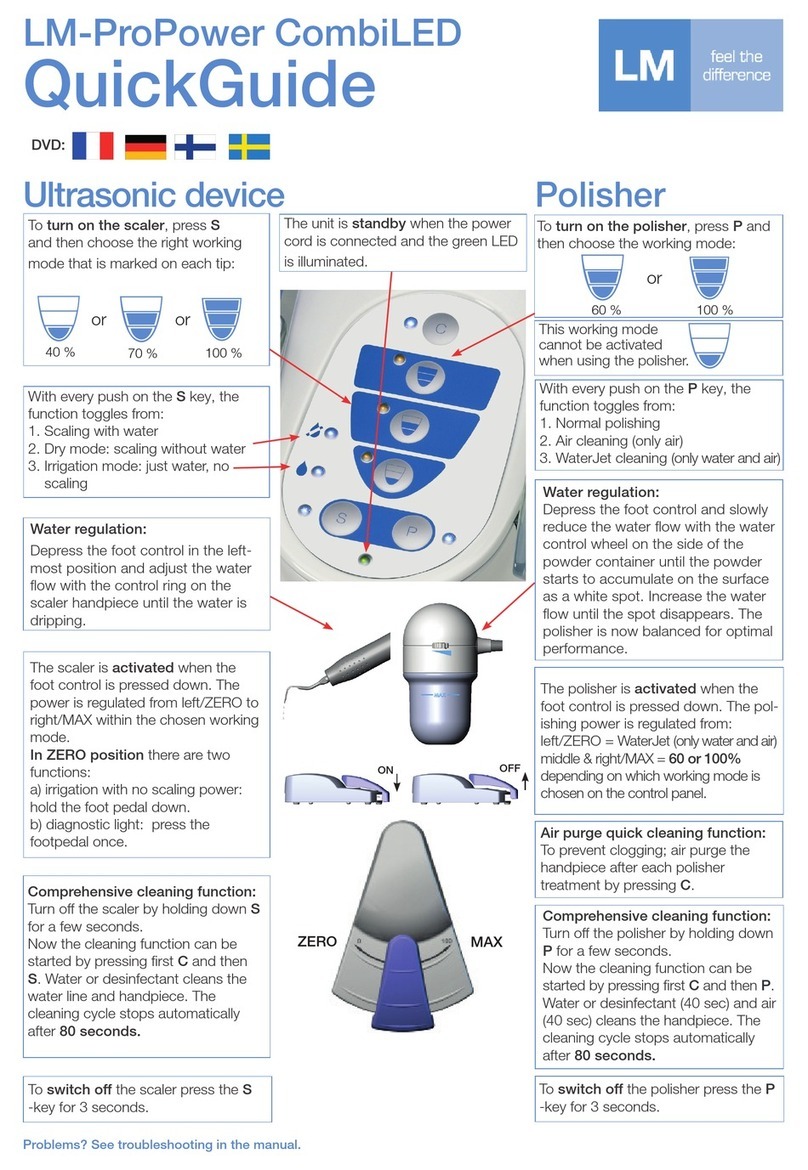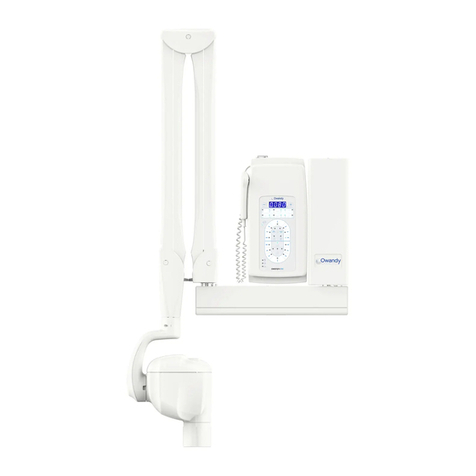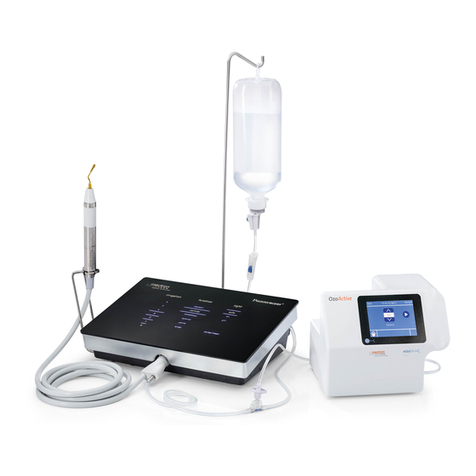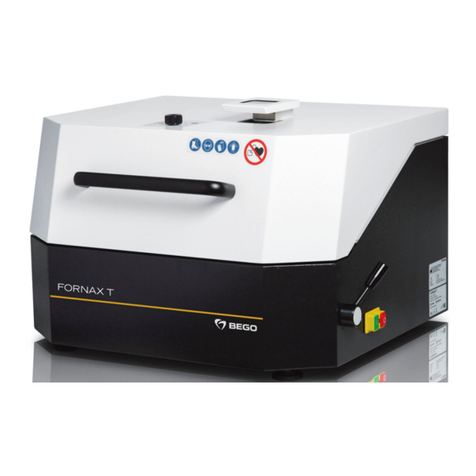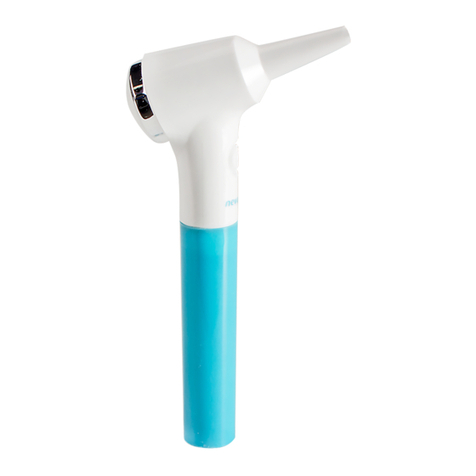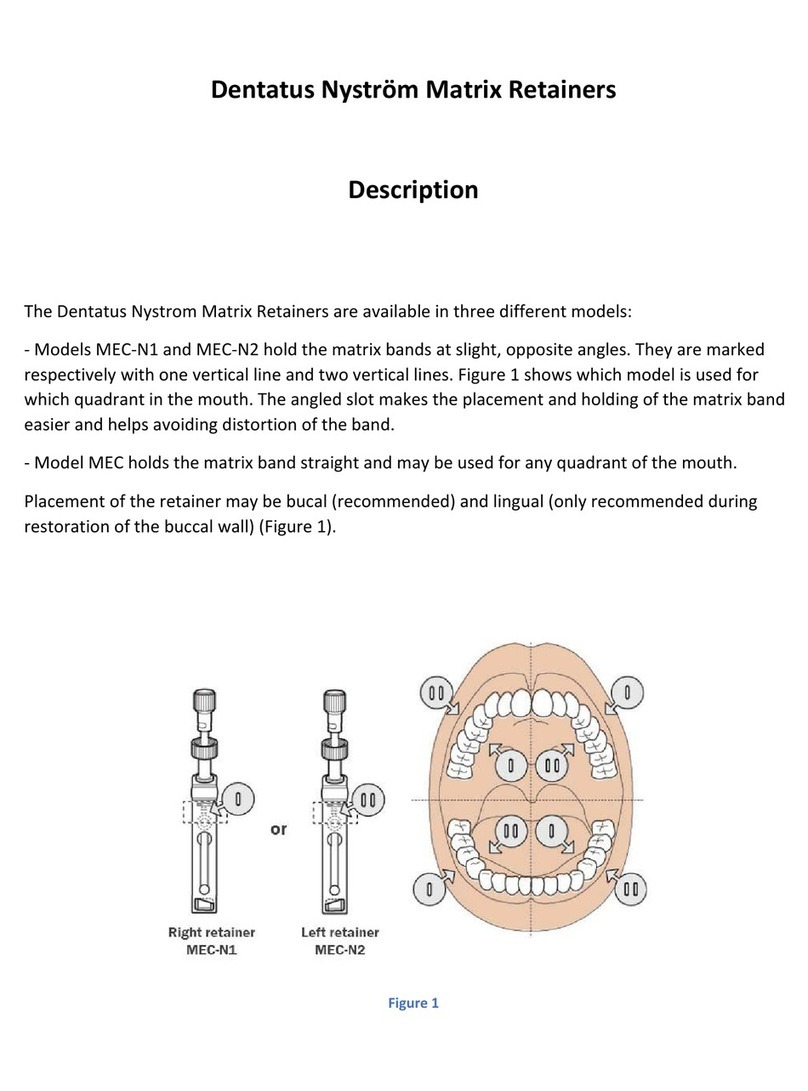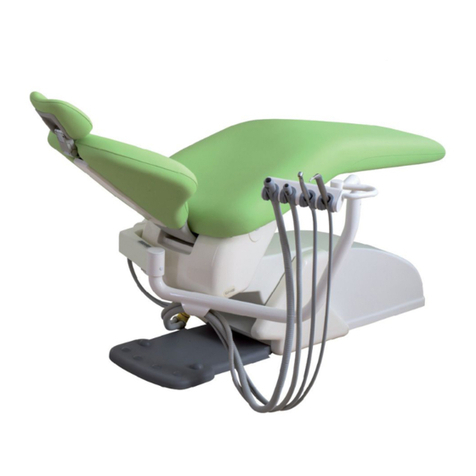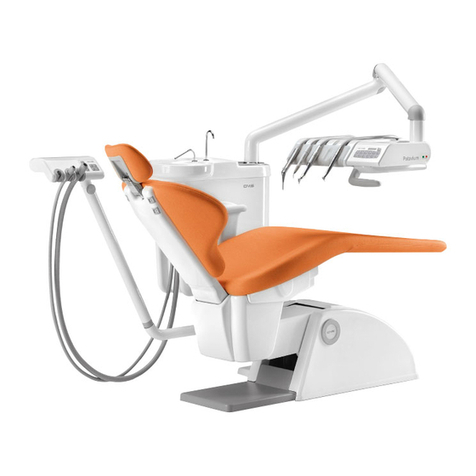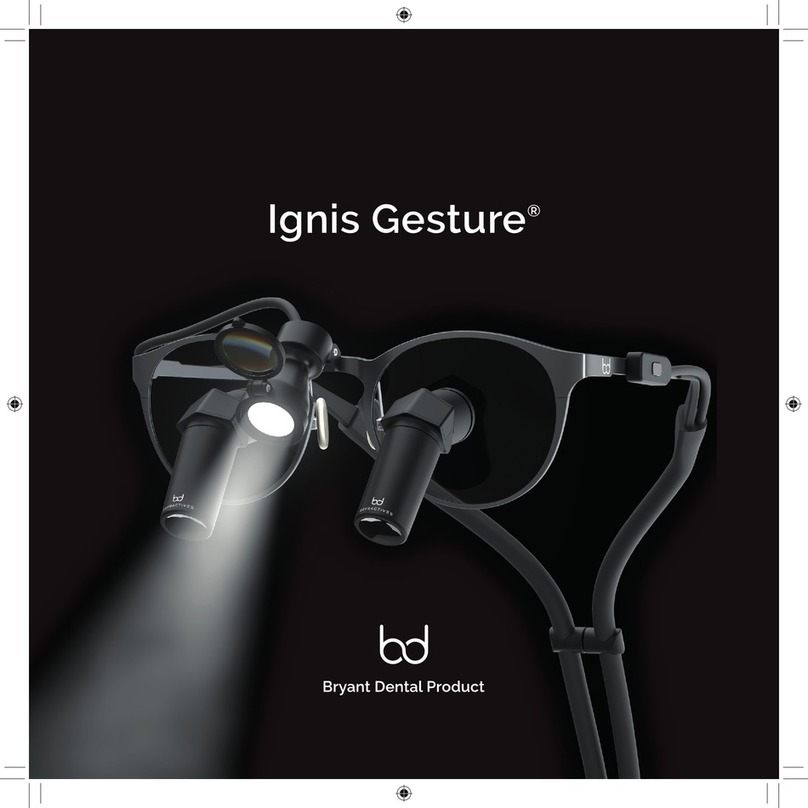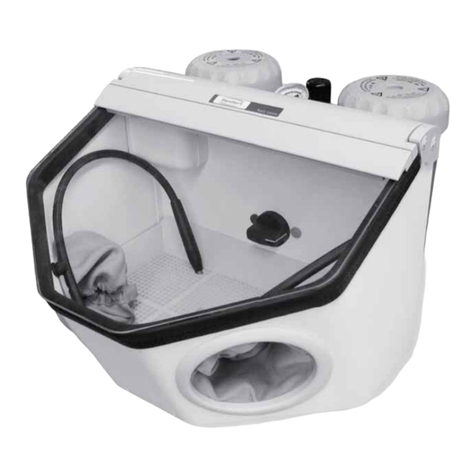Detax mollosil User manual

Denitive Direkt-Unterfütterung auf A-Silikonbasis,
dauerhaft weichbleibend, kalthärtend
mollosil®
mollosil® plus

2
Gebrauchsanweisung............................... 4
Mode d’emploi ..........................................18
FR
Istruzioni per l’uso....................................30
IT
Bruksanvisning..........................................72
NO
Instrukcja stosowania .............................78
PL
Manual de instruções..............................84
PT
DE
Instrucțiuni de utilizare ..........................90
RO
Bruksanvisning..........................................96
SV
Instructions for use ..................................12
EN
Modo de empleo......................................24
ES
Brugsanvisning..........................................36
Upute za uporabu ....................................48
HR
Naudojimo instrukcija ............................60
LT
Návod na použitie................................. 102
SK
Navodila za uporabo............................ 108
SL
Návod k použití...................................... 114
CS
DA
Használati útmutató............................. 120
HU
Инструкция по применению ......... 126
RU
Οδηγίες χρήσης.........................................42
EL
Lietošanas instrukcija..............................54
LV
Gebruiksaanwijzing.................................66
NL Kullanım kılavuzu .................................. 132
TR

3
1 2 3 4
5 6 7 8

4
ZWECKBESTIMMUNG
Denitive Direkt-Unterfütterung von Zahnprothesen
INDIKATION
Geeignet für alle PMMA-Kunststoe.
Anfertigung von dauerhaft weichbleibenden Unterfütterungen direkt in der Praxis oder indirekt im Labor.
Beseitigung von Druckstellen im OK- und UK-Bereich.
Zur Abdämmung der A-Linie bei Haftschwierigkeiten und Schlotterkamm.
Als elastischer Abschlussrand an OK-Prothesen und zur Lagesicherung der Prothesen durch erhöhte Adhäsion.
Zur elastischen Abdeckung scharfkantiger Alveolarfortsätze.
Zur Abdeckung von Implantatbereichen und als Overdentures.
PATIENTENZIELGRUPPE
Personen, die im Rahmen einer zahnärztlichen Maßnahme behandelt werden.
Lustrol und mollosil® plus Politur: Nicht für die Behandlung von schwangeren/ stillenden Frauen und Kindern verwenden.
Katalysatorkomponente enthält Alkylstannosiloxane.
VORGESEHENE ANWENDER
Zahnarzt/-ärztin, Zahntechniker/-in
DE

5
1.VORBEREITUNG DER PROTHESE
Entfernen der alten Unterfütterung (Abb. 1) Generell ist eine alte, vorhandene Unterfütterung komplett zu entfernen. Die zu unterfütternde Basis, je
nach Situation, ca. 1 – 2 mm abschleifen; an den Rändern vestibulär, lingual bzw. dorsal auf einer Höhe von ca. 2 – 3 mm eine mindestens 1 mm tiefe Stufe
einarbeiten; Prothesenränder abrunden und die Prothese gründlich reinigen.
Entfetten (Abb.2 ) Mit reinem, medizinischem Alkohol entfetten und trocknen lassen.
Auftragen des mollosil® plus Primers bzw. mollosil® Adhäsivs zur Haftvermittlung (Abb. 3): Alle beschlienen und zu unterfütternden Flächen, auf denen
das Material haften soll, gleichmäßig und vollständig ächendeckend mit mollosil® plus Primer bzw. mollosil® Adhäsiv bestreichen. mollosil® plus Primer
bzw. mollosil® Adhäsiv ca. 1 Min. trocknen lassen. Flasche nach Gebrauch sofort wieder verschließen. Speichel, Feuchtigkeit oder Monomerüssigkeiten
verhindern eine Haftung von mollosil® plus bzw. mollosil® auf der Prothese.
2. ANMISCHEN
mollosil® plus: Anwendung der Mischpistole / Dispenser
Kartusche gemäß spezieller Anleitung (separat erhältlich, Automix1 REF 02343, Automix2 REF 02699) einsetzen. Kartuschenverschluss entfernen und weg-
werfen; nicht wieder verwenden! Material leicht auspressen, bis es gleichmäßig aus beiden Önungen ießt. Mischkanüle auf die Kartusche aufsetzen und
benötigtes Material ausdrücken. Mischkanüle nach jedem Gebrauch als Verschluss auf der Kartusche belassen.
mollosil®: Auf einem Anmischblock mollosil® Base und Katalysator imVerhältnis 1:1 (gleiche Stranglängen) mit einem Spatel 30 Sek. homogen mischen.
3. DIREKTE UNTERFÜTTERUNG AM PATIENTEN
BeschichtenderProthese(Abb. 4): Prothesewie unter Punkt1 beschrieben vorbereiten.mollosil®plus-Kartuschenmaterial mittels Dispenser (siehe Punkt 2)
bzw. mollosil® mit dem Spatel(siehe Punkt 2) möglichstblasenfrei auf vestibuläre, linguale bzw. dorsale Ränder gleichmäßig ächendeckendauftragen.Danach
DE

6
restlicheProthesenbasisdeckend beschichten (Schichtstärke: min. 2 mm). Alle Prothesenbereiche,dieinGingivakontaktkommen, müssen beschichtet werden.
Ausführen der Funktionsbewegungen (Abb. 5): Die Prothese sodann in den Mund des Patienten eingliedern. Dieser soll den Mund in normal starker Ok-
klusion schließen. Der Abbindevorgang ist nach ca. 5 Min. abgeschlossen. Danach die unterfütterte Prothese aus dem Mund entnehmen und, wie in Punkt
5 beschrieben, ausarbeiten und lackieren.
4. INDIREKTE METHODE IM LABOR
Die zu unterfütternde Prothese in eine Küvette mit Gegenkonter einbetten. Zur leichteren Entnahme der Prothese Zahnreihen vor Ausgießen des Konters mit
Silikonüberziehen, z.B. mit Flexistone®Plus. Die Prothese aus der Küvetteentnehmen und dann, wie unterPunkt1 beschrieben, vorbereiten. Modell miteiner
üblichen Gips-Kunststo-Isolierung (Alginat) bestreichen. Wie unter Punkt 3 beschrieben, angemischtes mollosil®plus bzw. mollosil® möglichst blasenfrei,
gleichmäßig ächendeckend auf den zu unterfütternden Prothesenbereich applizieren (Schichtstärke: ca. 1 mm mehr, als zuvor weggefräst wurde). Küvette
mit Gegenkonter schließen und bei leichtem Pressdruck ca. 30 Min. unter einer Presse stehen lassen oder 10 Min. im Drucktopf bei 40 – 45 °C im Wasserbad.
Danach die Prothese aus der Küvette entnehmen und, wie unter Punkt 5 beschrieben, ausarbeiten und lackieren.
5. AUSARBEITEN UND LACKIEREN
GlättenderKanten:GrobeÜberschüssezunächstmiteinem scharfenSkalpellodereinerSchereentfernen(Abb. 6). Anschließend mit geeignetenrotierenden
Werkzeugen (z.B. Molloplast® Fräsen, Vorpolierern und Schleifkappen, ab ca. 8.000 U/Min.) unter leichtem Druck die Schnittkanten versäubern und glätten
(Abb. 7).
Politur (Abb. 8): mollosil® plus Politur bzw. Lustrol (für mollosil®) nur zum Glätten der beschlienen Funktionsränder verwenden. Alu-Siegelverschluss mit
einem Spatelönen undPipetten aufstecken. BeideFlüssigkeiten im Mischungsverhältnis 1:1 auf einenAnmischblock pipettieren, mit einem Spatel homogen
vermischen und mit einem Pinsel auftragen; ca. 5 Min. bei Raumtemperatur trocknen lassen.
DE

7
6. REINIGUNGSEMPFEHLUNG FÜR DEN PATIENTEN
Die unterfütterte Prothese mehrmals täglich mit einer weichen Zahnbürste und Neutralseife gründlich unter ießendem Wasser abbürsten und abspülen;
Reinigungsbad: max. 10 Min.
SICHERHEITSHINWEISE
►Nur für die angegebene Zweckbestimmung durch geschultes Fachpersonal.
►Beim Bearbeiten des unabgebundenen Materials persönliche Schutzausrüstung (Schutzhandschuhe, Schutzbrille) tragen.
►Beim Nachbearbeiten des ausgehärteten Materials entsprechend geeignete, persönliche Schutzausrüstungen (Schutzhandschuhe, Schutzbrille,
Mundschutz) tragen.
►Haftung ist nur auf aufgerauten und mit mollosil® plus Primer bzw. mollosil® Adhäsiv bestrichenen Flächen gewährleistet!
►Augenkontakt mit Katalysator vermeiden, ggf. Augen sofort mit ießendem Wasser gründlich spülen und sofort Augenarzt aufsuchen.
►mollosil® plus Primer bzw. mollosil® Adhäsiv ächendeckend auftragen!
►Alle zu unterfütternden Prothesenbereiche, die mit der Gingiva in Kontakt kommen, müssen mit mollosil® plus bzw. mollosil® gleichmäßig und
ächendeckend beschichtet sein, da sonst Haftungsprobleme auftreten können!
►Abbindezeiten unbedingt einhalten!
►mollosil® Adhäsiv, mollosil® plus Primer, mollosil® plus Politur und Lustrol:Von Zündquellen fernhalten.
►Gefahren- und Sicherheitshinweise aus dem entsprechendem Sicherheitsdatenblatt entnehmen.
DE

8
HINWEISE
►DETAX haftet nicht für Schäden, die durch fehlerhafte Anwendung hervorgerufen werden.
►mollosil®: Basen- und Katalysator-Komponente dürfen nur von derselben Charge verwendet werden.Tubenverschlüsse nicht vertauschen!
►Sicherheitsdatenblatt beachten!
Für Anwender und/oder Patienten:
Alle im Zusammenhang mit diesem Produkt aufgetretenen schwerwiegenden Vorfälle sind unverzüglich unter [email protected] sowie an die zuständige
Behörde des Mitgliedstaats, in dem Anwender und/oder Patient niedergelassen ist, zu melden.
KONTRAINDIKATION
Das Material nicht bei bekannten Allergien gegen einen der Inhaltsstoe oder bei Kontaktallergien verwenden. UnerwünschteWirkungen sind bei sachge-
rechter Anwendung nicht zu erwarten. Immunreaktionen z.B. Allergien, Irritationen könnenjedoch grundsätzlich nicht ausgeschlossen werden. Im Zweifelsfall
empfehlen wir, vor der Anwendung einen Allergietest durchzuführen.
ENTSORGUNG
Die Entsorgung des Inhalts/des Behälters gemäß den örtlichen/regionalen/nationalen und internationalenVorschriften durchführen.
DE

9
SYMBOLERLÄUTERUNG
* ab Mischbeginn bei 23 °C ± 2 °C, 50 ± 5 % rel.
Luftfeuchtigkeit. Höhere Temperaturen verkürzen,
niedrigere verlängern die angegebenen Zeiten.
15 °C
59 °F
25 °C
77 °F
Lagerung:Verarbeitung:
Bei 23 °C ± 2 °C, 50 ± 5%
rel. Luftfeuchtigkeit
Medizinprodukt siehe Falz
Technische Daten mollosil® mollosil® plus
Mischvolumen 2 x 50 ml (Tuben)
2 x 30 ml (Tuben) 50 ml Kartuschen
Produktfarbe Base/Katalysator rotbraun / hellblau rotbraun / weiß
Anmischzeit ca. 30 Sek. manuell entfällt (Automix-System)
Verarbeitungszeit* ca. 1 Min. 30 Sek. ca. 1 Min. 30 Sek.
Abbindezeit* ca. 7 Min. ca. 6 Min. 30 Sek.
Verweildauer im Mund ca. 5 Min. 30 Sek. ca. 5 Min.
Endhärte ca. 28 Shore A ca. 28 Shore A
Mischkanüle —
Automix2, rosa;
Art. -Nr.: 02770
Automix1;
Art. -Nr.: 02344
DIN EN ISO 10139-2 Typ A, weich

10
Bestellinformation
mollosil®
Standardpackung 03005
Base, Tube 50 ml
Katalysator, Tube 50 ml
Adhäsiv, Flasche 5 ml
Lustrol Glanzlack,
Flaschen 2 x 6 ml
2 Pipetten
Starter kit 02274
Base, Tube 30 ml
Katalysator, Tube 30 ml
Adhäsiv, Flasche 5 ml
Lustrol Glanzlack,
Flaschen, 2 x 6 ml
2 Pipetten
mollosil® plus Automix1
Standardpackung 02436
50 ml Kartusche
5 ml Primer
2 x 7 ml Politur
7 Mischkanülen, 6 mm
1 Schleifkappe
1 Schleifkappenträger
2 Pipetten
Rell Packung Automix1 02439
50 ml Kartusche
mollosil® plus Automix2
Standardpackung 02353
50 ml Kartusche
5 ml Primer
2 x 7 ml Politur
7 Mischkanülen, rosa
1 Schleifkappe
1 Schleifkappenträger
2 Pipetten
Rell Packung Automix2 02354
50 ml Kartusche

11
mollosil® plus Automix2
Standardpackung 02353
50 ml Kartusche
5 ml Primer
2 x 7 ml Politur
7 Mischkanülen, rosa
1 Schleifkappe
1 Schleifkappenträger
2 Pipetten
Rell Packung Automix2 02354
50 ml Kartusche
mollosil® Adhäsive 03007
5 ml Flasche
Lustrol gloss varnish
2 x 6 ml Flasche 03008
Primer 02440
5 ml Flasche
Politur 02441
2 x 7 ml Flasche
Schleifkappen 02615
spitz, 10 St.
Schleifkappenträger 02616
spitz, 1 St.
good morning spray
Standardpackung 02284
100 ml
Mischkanülen Automix 2 02707
rosa, 48 pcs.
Mischkanülen Automix 1 02344
6 mm, 48 pcs.

12
INTENDED USE
Denitive direct relining of dental prostheses
INDICATION
Suitable for all PMMA-based plastic materials.
Production of permanently soft relinings directly at the chairside or indirectly in the laboratory.
Removal of pressure points in the mandibular and maxillary areas.
For post-damming the Aline in case of adhesion problems and abby ridges.
As an elastic margin on maxillary dentures and for securing the position of the dentures by increased adhesion.
For elastic covering of sharp-ridged alveolar processes.
For covering implant areas and as overdentures.
PATIENT TARGET GROUP
Persons being treated in the context of a dental procedure.
Lustrol and mollosil® plus polish: Do not use for the treatment of pregnant/breastfeeding women and of children. Catalyst component contains alkyl
stannosiloxanes.
INTENDED USERS
Dentist, dental technician
EN

13
1. PREPARATION OF THE DENTURE
Removal of the old relining (Fig. 1) In general, an existing relining must be removed completely. Grind o the base to be relined by approx. 1 - 2 mm,
depending on the situation; at the vestibular, lingual or dorsal edges, incorporate a shoulder approx. 2 - 3 mm in height with a step of at least 1 mm; round
o the borders of the denture and clean the denture thoroughly.
Degreasing (Fig.2) Degrease with pure, medical alcohol and allow to dry.
Application of the mollosil® plus primer or mollosil® adhesive for adhesion (Fig. 3): All surfaces ground and to be relined to which the material is required
to adhere must be evenly and completely covered with mollosil® plus primer or mollosil® adhesive. Let mollosil® plus primer mollosil® Adhesive dry for
approx. 1 minute. Close the bottle immediately after use. Saliva, moisture or monomer liquids prevent adhesion of mollosil® plus or mollosil® to the denture.
2. MIXING
mollosil® plus: Application of the mixing jet / dispenser
Insert the cartridge according to special instructions (separately available, Automix1 REF 02343, Automix2 REF 02699). Remove and discard cartridge closure;
do not reuse! Slightly squeeze material until it ows evenly out of both openings. Mount the mixing cannula on the cartridge and squeeze out the required
material. Leave the mixing cannula on the cartridge as a closure after each use.
mollosil®: On a mixing block, mix mollosil® base and catalyst homogeneously at a ratio of 1:1 (equal strand lengths) with a spatula for 30 seconds.
3. DIRECT CHAIRSIDE RELINING
Coatingofthedenture(Fig. 4):Prepare the denture as described under item 1. Apply mollosil®plus cartridge material by means of a dispenser (see item 2) or
mollosil®with the spatula (seeitem 2), taking care to avoid bubbles, to thevestibular, lingual or dorsal borders,respectively, covering the entire surface evenly.
Thencoatthe remaining prostheticbaseplatecompletely (layerthickness:min.2mm).Alldenture areasthatcomeintocontact with the gingivamustbecoated.
EN

14
Perform the functional movements (Fig. 5): Then place the denture in the patient’s mouth. Let him/her close the mouth in normal occlusion. The curing
process is completed after approx. 5 minutes. Then remove the relined denture from the mouth, and trim and paint it as described in item 5.
4. INDIRECT METHOD IN THE LABORATORY
Invest the denture to be relined into a ask with counter. For easier removal of the denture, cover the teeth with silicone before pouring the counter, e.g. with
Flexistone® Plus. Remove the denture from the ask and then prepare it as described in item 1. Coat the model with a standard plaster-plastic insulation
(alginate). As described under item 3, apply mixed mollosil®plus or mollosil®, respectively, taking care to avoid bubbles, evenly over the entire surface of
the denture area to be relined (layer thickness: approx. 1 mm more than previously milled away). Close the ask with the counter and leave it under a press
for approx. 30 min. with light pressure, or in a pressure pot at 40 - 45 °C / 104 - 113 °F in a water bath for 10 min. Then remove the denture from the ask
and trim and paint it as described in item 5.
5. FINALTRIMMING AND PAINTING
Smoothing of the borders: First remove coarse excess with a sharp scalpel or scissors (Fig. 6). Then use suitable rotating tools (e.g Molloplast® cutters, pre-
polishers and grinding sleeves, from approx. 8,000 RPM) with light pressure to clean and smooth the cut borders (Fig. 7).
Polish (Fig. 8): mollosil® plus polish or Lustrol (for mollosil®) should be used only to smooth the ground functional borders. Open the aluminum seal with a
spatula and plug on pipettes. Pipette both liquids at a mixing ratio of 1:1 onto a mixing block, mix homogeneously with a spatula, and apply with a brush;
allow to dry for approx. 5 min. at room temperature.
6. CLEANING RECOMMENDATION FOR THE PATIENT
Thoroughly brush and rinse the relined denture several times a day with a soft toothbrush and neutral soap under running water; cleaning bath: max. 10 min.
EN

15
SAFETY INFORMATION
►Only for the specied intended use by trained specialists.
►Wear personal protective equipment (protective gloves, goggles) when handling the uncured material.
►Wear suitable personal protective equipment (protective gloves, goggles, face mask) when nishing the cured material.
►Adhesion is ensured only on roughened surfaces that have been coated with mollosil® plus primer or mollosil® adhesive!
►Avoid eye contact with catalyst, rinse eyes immediately with plenty of owing water if necessary, consult ophthalmologist immediately.
►Apply mollosil® plus primer or mollosil® adhesive over the entire surface!
►All dentureareas to be relinedthat will come intocontactwith thegingiva must be evenlyand completely coated withmollosil® plus or mollosil®, otherwise
adhesion problems may occur!
►Curing times must be complied with!
►mollosil® adhesive, mollosil® plus primer, mollosil® plus polish and Lustrol: Keep away from sources of ignition.
►Refer to the relevant safety data sheet for hazard and safety information.
NOTES
►DETAX shall not be held liable for any damage caused by misuse.
►mollosil®: Make sure that only base and catalyst components from the same batch number are used. Do not mix up tube caps!
►Read and understand the safety data sheet!
For users and/or patients:
Any serious incident that has occurred in connection with this product must be reported immediately to [email protected] and to the competent public
authority of the country in which the user and/or patient resides.
EN

16
CONTRAINDICATION
Do not use this material in case of known allergies to any of the ingredients, or contact allergies. Undesirable eects are not to be expected in case of proper
application. However, as a matter of principle immune reactions such as allergies or irritations cannot be ruled out. In case of doubt, we recommend per-
forming an allergy test before application.
DISPOSAL
Disposal of the contents/container must be carried out in accordance with the local/regional/national and international regulations.
EN

17
SYMBOLS
* from start of mixing at 23 ± 2 °C / 73 ± 3 °F, 50 ± 5 %
of rel. humidity. Higher temperatures shorten, lower
temperatures extend the indicated times.
15 °C
59 °F
25 °C
77 °F
Storage:Processing:
At 23 ± 2 °C / 73 ± 3 °F ,
50 ± 5% of rel. humidity
Medical device see fold
Technical specications mollosil® mollosil® plus
Mixing volume 2 × 50 ml (tubes)
2 × 30 ml (tubes) 50-ml cartridges
Product color base/catalyst red-brown / light blue red-brown / white
Mixing time approx. 30 sec manually not applicable (Automix system)
Open time* approx. 1 min 30 sec. approx. 1 min 30 sec.
Curing time* approx. 7 min. approx. 6 min 30 sec.
Retention time in the mouth approx. 5 min 30 sec. approx. 5 min.
Final hardness approx. 28 Shore A approx. 28 Shore A
Mixing cannula —
DIN EN ISO 10139- 2 type A, soft
Automix2, pink;
item №: 02770
Automix1;
item №: 02344

18
DESTINATION
Rebasage direct dénitif de prothèses dentaires
INDICATION
Adapté à tous les plastiques PMMA.
Réalisation de rebasages souples à long terme directement, en cabinet, ou indirectement, en laboratoire.
Suppression des points de pression dans la mâchoire inférieure et la mâchoire supérieure.
Pour amortir la pression de la ligne A en cas de problèmes d’adhésion et de crêtes ottantes.
Comme bord élastique pour les prothèses de mâchoire supérieure et pour assurer la position des prothèses en renforçant l’adhérence.
Pour le revêtement élastique des os alvéolaires acérés.
Pour le revêtement des zones implantaires et comme overdenture.
GROUPE DE PATIENTS CIBLÉS
Personnes qui doivent faire l’objet de mesures dentaires.
Lustrol et solution de polissage mollosil® plus: Ne pas utiliser chez les femmes enceintes ou allaitantes et les enfants. Le composant catalyseur contient
du siloxane alkyle.
UTILISATEURS VISÉS
Dentistes, prothésistes dentaires
FR

19
1. PRÉPARATION DE LA PROTHÈSE
Retrait du rebasage existant (ill. 1) :Généralement, le rebasage existant doit être complètement éliminé. Selon la situation, meuler la base à rebaser
d’une épaisseur d’environ 1 à 2mm; sur les bords vestibulaires, linguaux ou dorsaux proler une arête d’une profondeur d’au moins 1mm à une hauteur
d’environ 2 à 3mm; arrondir les bords de la prothèse et nettoyer soigneusement la prothèse.
Dégraissage (ill.2) : Dégraisser avec de l’alcool pur à usage médical et laisser sécher.
Applicationdu primer mollosil® plus oude l’adhésifmollosil®pour l’adhésion(ill.3): Appliquer homogènement et complètement sur toutes les surfaces
taillées à rebaser auxquelles le matériau doit se xer une couche de primer mollosil® plus ou d’adhésif mollosil®. Laisser sécher environ 1minute le primer
mollosil® plus ou l’adhésif mollosil®. Refermer immédiatement le acon après l’utilisation. La salive, l’humidité ou les liquides monomères empêchent
l’adhésion de mollosil® plus ou de mollosil® sur la prothèse.
2. MÉLANGE
mollosil® plus: Utiliser le pistolet mélangeur / distributeur
Insérer la cartouche conformément aux directives spéciales (disponibles séparément, Automix1 REF 02343, Automix2 REF 02699). Retirer et jeter le
bouchon de cartouche; ne pas le réutiliser! Faire sortir une petite quantité de matériau, jusqu’à ce qu’il sorte des deux orices d’une manière homogène.
Insérer la canule de mélange sur la cartouche et faire sortir la quantité nécessaire de matériel. Laisser la canule de mélange comme bouchon sur la
cartouche après chaque utilisation.
mollosil®: Sur un bloc de mélange, mélanger de façon homogène avec une spatule pendant 30secondes mollosil® Base et le catalyseur dans une
proportion de 1:1 (longueurs de produit identiques).
FR

20
3. REBASAGE DIRECT EN BOUCHE DU PATIENT
Revêtement de la prothèse (ill. 4): Préparer la prothèse comme indiqué au point1. Appliquer de façon homogène et sans bulle mollosil® plus en
cartouche avec le distributeur (voir point2) ou mollosil® avec la spatule (voir point2) sur les bords vestibulaires, linguaux ou dorsaux. Enduire ensuite
complètement la base de prothèse restante (épaisseur du matériau de 2mm au minimum). Toutes les parties de la prothèse en contact avec la gencive
doivent être recouvertes de matériau.
Exécution des mouvements fonctionnels (ill. 5): Insérer la prothèse dans la bouche du patient. Celui-ci doit pouvoir fermer la bouche en occlusion
normale. Le durcissement est terminé après 5minutes env. Retirer ensuite la prothèse rebasée de la bouche du patient. La nition et le vernissage se
font comme décrit au point 5.
4. MÉTHODE INDIRECTE EN LABORATOIRE
Revêtir la prothèse à rebaser dans un moue couvert d’une contrepartie. An de pouvoir retirer plus facilement la prothèse, enduire les dents d’une couche
de silicone, p.ex. de Flexistone® Plus avant de couler le contre-moue. Enlever la prothèse du moue et la préparer selon les indications du point 1. Enduire
le modèle d’un isolant plastique-plâtre (alginate) usuel. Comme décrit au point 3, appliquer homogènement la masse mélangée de mollosil® plus ou
mollosil® sans bulles dans la mesure du possible sur toute la zone de la prothèse à rebaser (épaisseur de couche: env. 1mm de plus que l’épaisseur fraisée
auparavant). Fermer le moue avec contrepartie et mettre sous presse avec une pression légère pendant 30 minutes env. ou dans une cuve sous pression
à 40-45°C pendant 10 minutes au bain-marie. Retirer ensuite la prothèse du moue et eectuer la nition et le vernissage comme décrit au point 5.
5. FINITION ET VERNISSAGE
Lissage des bords: Éliminer l’excédent de matériau à l’aide d’un scalpel ou de ciseaux alés (ill. 6). Nettoyer et lisser ensuite les arêtes de coupe sous
pression légère avec des instruments rotatifs appropriés (par ex. fraises, prépolissoirs et chapes abrasives Molloplast®, à partir d’env. 8000tours par
minute) (ill. 7).
FR
This manual suits for next models
16
Table of contents
Languages:
Other Detax Dental Equipment manuals
